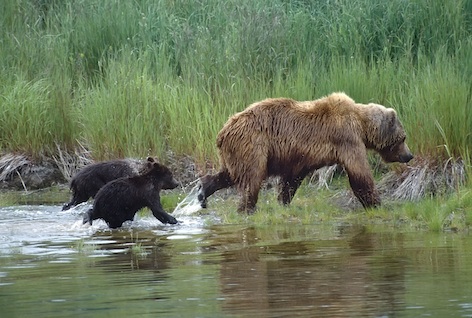Let’s go on a bear hunt - an online bear hunt!
You are about to embark on the greatest bear hunt of your life!
On this hunt you will search, online, to find the facts about one of the eight bear species.
There are eight species (kinds) of bears
American black bears
Asiatic black bears
Brown bears
Giant pandas
Malayan sun bears
Polar bears
Sloth bears
Spectacled bears
Task
Choose one species from the list of eight to investigate, either on your own or with a partner.
Your task is to make an information poster, chart or book about your chosen bear.
You will share this with the class and give a talk about the bear species. If you are not in a class, perhaps being home schooled, you can share online with others or give the talk to your family.
You will also make up a True or False Quiz about your chosen bear based on the facts in your presentation. Invite others to do the quiz.
Resources
You can find information about all of the eight species of bears on kidcyber’s animals index: www.kidcyber.com.au/animals
For further websites for more information: Great Bear Hunt resources
Other resources:
You can also search for other websites about your chosen bear. Be specific.. enter the name of your chosen bear into a search engine because just putting bears will be too general. Sometimes you can add for kids to help find kid-friendly websites, for example : information for kids about xxxx bears.
Process
Start by making a list of 8 focus questions about your bear that you will find answers for. You will find information about each of these as you read information.
Want help writing questions? Think of these question words as starting words: What? Where? Why? How? When? Who?
Organise your information
When you make notes, write them under the questions you’ve written. Using kidcyber data charts will help this organisation. Draw data charts like this:
As you research, write down key facts under each of your questions, and make sketches that will be used to illustrate your poster.
REMEMBER: don’t copy sentences from the texts. They are someone else’s work and you should use your own words and sentences!
When you think you have enough information start writing your text, making up your own sentences. Arrange the sentences in a satisfactory order.
Check your spelling
Don't forget to check your spelling. Have your teacher or parent check your first draft before you start the on the final draft for the poster. (You might ask other students or adults to proof read your draft and suggest changes or additions too!
Presentation
1. Poster/chart
Your information poster/chart about your chosen bear to be displayed for the class and talk about it.
Lay out the text and the illustrations, rearranging them until you are satisfied with the poster design.
Here are a couple of layout ideas for your poster
Layout A
Layout B
Layout A - combines pamphlet and a poster. Plenty of space for facts and illustrations.
Layout B - Space is provided for the most important information in the central circle. Other facts and illustrations are placed in a grid below.
Notice that both have used background colour and images.
2. A True/False Quiz
Make the quiz available to people reading your poster, chart or book. Write some statements that can be answered by reading the poster.
For example:
Giant Pandas live only in China. True/False
Giant Pandas eat animals and insects. True/False
Giant Pandas are endangered. True/False
Bibliography
Remember: On one section of your poster/chart/book you must list the resources you used to answer your questions. You need to note the names of the sources of your information when you use them.
One way to do it is like this:
Sydenham & Thomas. 2020. Black Bears. [Online] www.kidcyber.com.au
Self-Evaluation
It’s valuable to think about how you went: did you get lots of good information, and did you feel good about your presentation? Were there some things you’d like to do better in your next project?
After your presentation, think about how you went in this project. What do you think you did really well? There will probably be things you want to improve on next time you do research: these can be set as goals. Make some notes.
Discuss your evaluation with your teacher.





